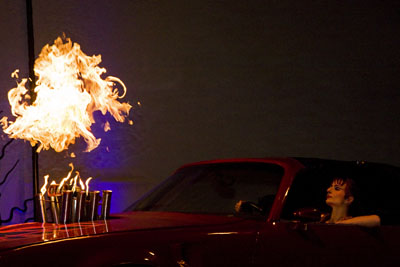The Crucible’s Second Annual Benefit Fire Ballet

Passions ignite at The Crucible foundry in Oakland, CA.
Down by the West Oakland Bart station, often late into the night, one may observe mysterious flickering lights accompanied by loud explosions. If it ain’t gunshots, you can be sure some welder, sculptor or pyrotechnics whiz at the Crucible foundry is burning the midnight oil.
Founded by Michael Sturtz in 1999, this nonprofit educational hub of fine and industrial arts has attracted a highly motivated group of artists, artisans and students from all over the country. “From cast iron to neon, and from large-scale public art to the most precise kinetic sculpture, The Crucible is fast becoming the best-equipped public industry & arts education facility on the West Coast.”

Ballet star Tina Bohnstedt cruises in a vintage Pontiac (Firebird, natch).
Photo by Gary Wilson
Last year, audiences were astounded by the collective’s incendiary production of Romeo and Juliet. Their second annual “benefit fire ballet”, a decidedly ballsy interpretation Stravinsky’s Firebird, opens tonight:
[A] unique fusion of classical ballet, aerialists, acrobats, fire performers, break dancers…paired with fire and industrial arts. It’s definitely ballet with an industrial edge provided by Crucible artisans, a cameo appearance by a Pontiac Firebird, and a ballerina’s graceful pas-de-deux with a motorcycle stunt rider.
The production’s running every night through the 12th, with additional shows on the 16th, 17th and 19th. Proceeds from ticket sales will go directly towards supporting the Crucible school. All shows are expected to sell out, so if you’re thinking of going (and I know folks as far away as San Diego and Portland are making the trip) get your tickets in advance.
















